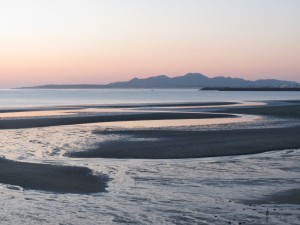I was mesmerized by the power of water last week. Our family vacation began in water-rich Northern California, continued through the entire Central Valley, ending at the arid Sea of Cortez in Baja Mexico.
(Of the 600 photographs taken, 22 of my favorites can be found here: http://goo.gl/M1TcZ).
The trek to the Bay Area is a familiar one, but I still marvel at the pale green of new growth on orchard trees and how the hills of Zamora brighten with just the slightest bit of rain.
The next morning we piled into Dad’s Honda Civic and met up with the Delta-Mendota Canal as the sun rose over the Central Valley. Along Highway 5, you follow the carefully-corralled water through most of the state — with crops on either side including fields, nut orchards, grape vines and citrus groves.
Occasionally we passed lifeless orchards. Yellow, hand-painted signs read: “Congress-created dust bowl.”
Onward we passed Pyramid Lake near Castaic, just up the way from Six Flags Magic Kingdom. Road signs also pointed toward Palmdale, where the County of Butte sells water from Lake Oroville.
After the metropolis of Los Angeles, the land turns again to agriculture, with the Imperial Valley and its water supply.
You can tell when the water begins to diminish, as the green fields are replaced by tidy rows of date palms.
Nearing the California/Mexican border, the land changes again, with dusty towns of Brawley and El Centro looking like all color has been bleached by the sun.
Past the Mexican border at Calexico/Mexicali, another flush of green farms appeared, but soon turned to rough sand as we traveled several hours across the Sonora Desert.
I’ve crossed this road before and learned to appreciate the stark beauty of the rough mountain range, with various tones of gray and black.
Farther south is a remarkable half-hour stretch of road over flat, sun-crusted sand where not a stitch of plant-life can be seen on either side of the road. The monotony is broken only by the almost comical number of tires and discarded glass bottles that glint in the sun.
By the time we reached San Felipe, a little fishing village, the sparse ocotillo trees in bloom and proud cactus were a welcome contrast to the recent nothing-ness.
Lack of fresh water means none of the shade trees and landscaping of home, but water in the sea becomes the central thrust for life.
On the wide-open beaches, we watched sand crabs by the thousands drift in with the tide, and more just below the sand’s surface when we made our hands into shovels.
Mid-week, we traveled by panga boat for about an hour into the sea, stopping at a giant rock painted white with bird dung.
Alex, the boat’s captain, chose the spot because the full moon and strong current meant fish would be more difficult to catch closer to shore.
The rock is where seals multiply and pelicans were so thick you’d have a hard time finding a spot to place a lawn chair.
And then, there are the sunrises over the Gulf of Mexico, which make you forget for a few minutes that there is anything else but you and God.
While it would be easy to compare Mexico to Northern California and find it dry and lifeless, life was thriving in the sea water.
And, of course, no trip would be complete without checking out the horticultural options — at San Felipe Nursery.
My Auntie Pat had been craving a (Mexico-tolerant) bougainvillaea plant for her small front yard. She already has fruit on her tomato plant, neglects an assortment of cacti and has a shaded area for nasturtium.
Bougainvillaea is among the best-sellers at the town’s only nursery, as well as a wildly diverse assortment of cacti, palms, ficus, succulents and miscellaneous plants that are meant to be planted and die before the season changes.
After the very long drive back to Northern California, it was strange to meet the first day with a fresh rain storm.
In Butte County, the land easily returns to green at this time of year, and soon I’ll be enjoying the fleeting flush of wildflowers.

